 |
 |
 |
| |
Issues in Hepatitis C: Identification, Access to Care, and Cost
|
| |
| |
Reported by Jules Levin
DDW 2015 - Digestive Disease Week 2015, May 16-19, 2015, Washington D.C.
Nancy Reau, MD, FAASLD
Associate Professor of Medicine
University of Chicago



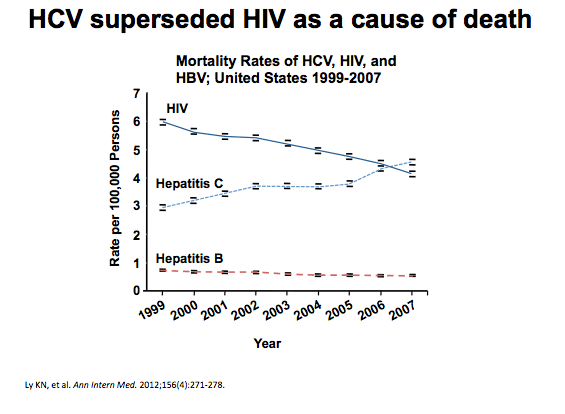
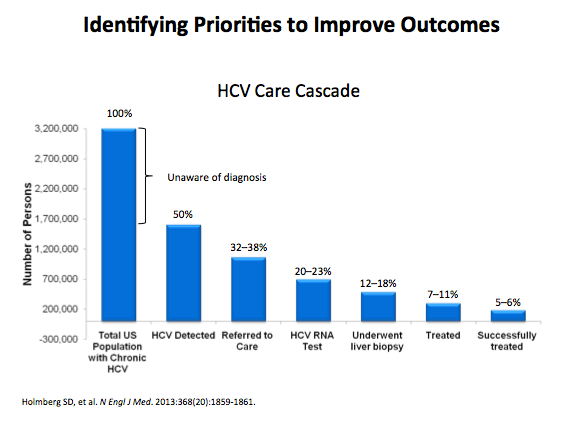
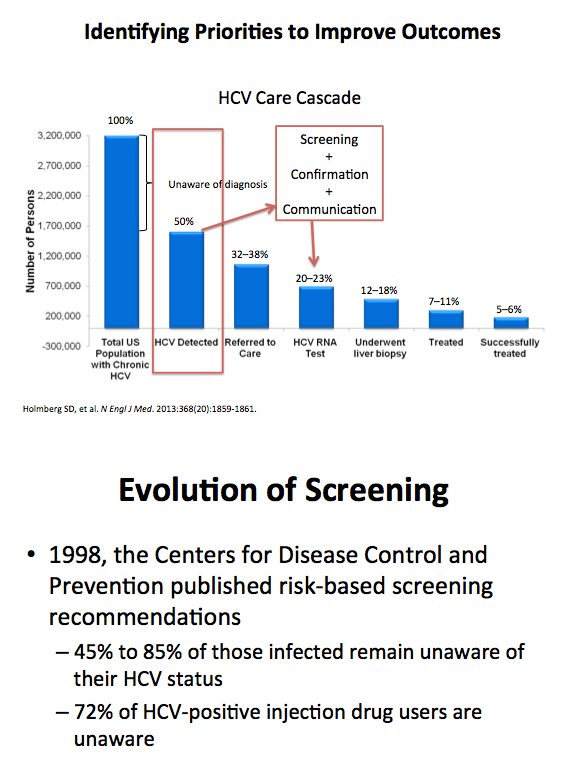

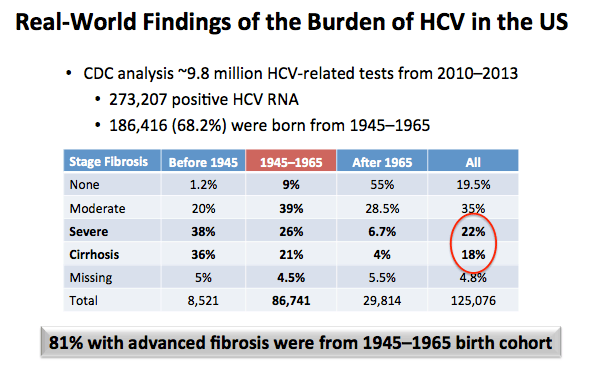
Alarmingly, her analysis of data on a very large number of HCV tests conducted between 2010-2013 revealed that about one-half of HCV-infected persons born from 1945-1965 already had severe fibrosis or cirrhosis.
CDC- CROI (Klevens M, et al. CROI 2015. Abstract 145)
In the United States, the CDC recommends one-time HCV antibody testing for persons born from 1945 to 1965 due to the higher prevalence of HCV infection in this group.
The study found that a total of 273,143 persons had a first positive HCV-RNA test result and known date of birth. Of these, 68.2 percent were born from 1945 till 1965. During the study period (2010-2013) 42.3 percent of persons in the birth cohort had moderate fibrosis, followed by severe fibrosis (28.7 percent) and cirrhosis (22.7 percent).
About one-half of HCV-infected persons born from 1945-1965 had severe fibrosis or cirrhosis
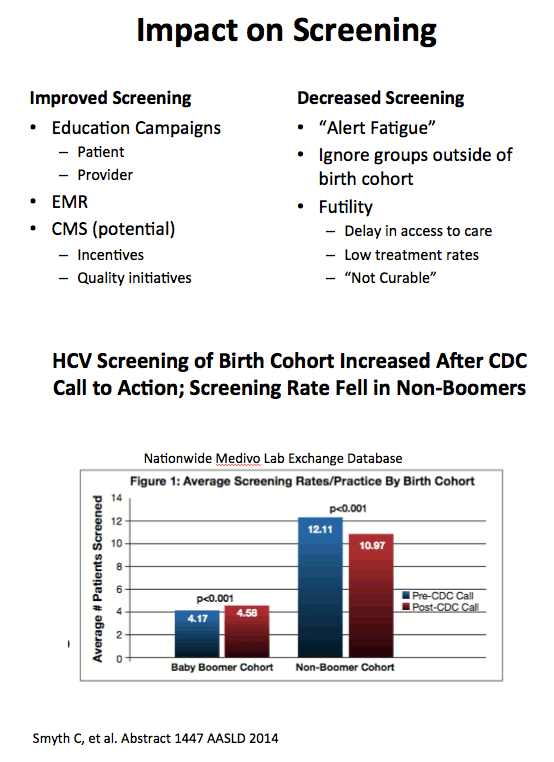
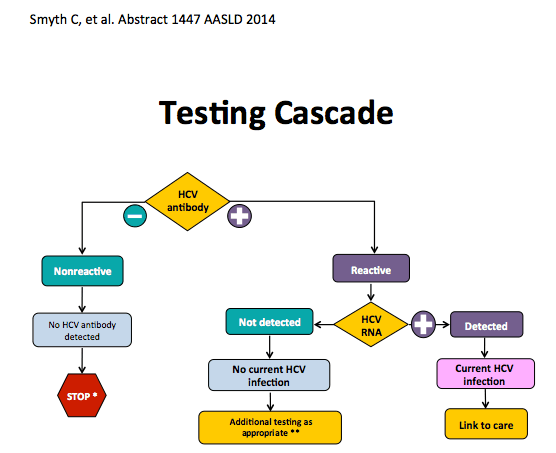
* For persons who might have been exposed to HCV within the past 6 months, testing for HCV RNA or follow-up testing for HCV antibody is recommended.
For persons who are immunocompromised, testing for HCV RNA can be considered.
** To differentiate past, resolved HCV infection from biologic false positivity for HCV antibody, testing with another HCV antibody assay can be considered.
Repeat HCV RNA testing if the person tested is suspected to have had HCV exposure within the past 6 months or has clinical evidence of HCV disease, or if there is concern regarding the handling or storage of the test specimen.
CDC. Testing for HCV infection. MMWR. 2013;62(18).
CDC. Recommended Testing Sequence for Identifying Current Hepatitis C Virus (HCV) Infection. http://www.cdc.gov/hepatitis/hcv/labtesting.htm.
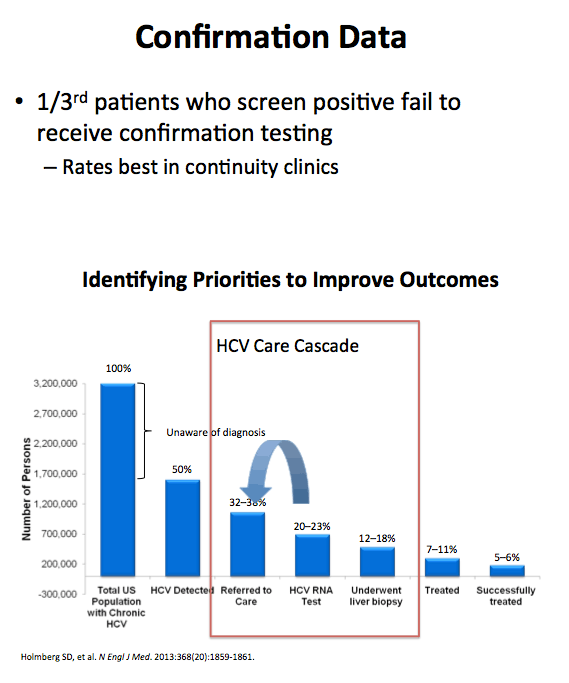
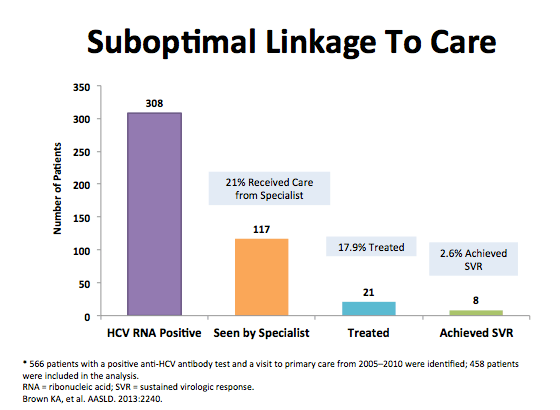
Brown KA, Nerenz DR, Atkinson R, et al. Barriers to cure for hepatitis C: data from a large integrated health system. AASLD Annual Meeting Abstracts 2013:2240
Patients with a positive anti-HCV antibody test and visit to primary care from 2005-2010 (n=566).
Of these patients, 458 underwent HCV RNA testing.
Brown KA, et al. Hepatology. 2013;58(suppl 1):1291A. Abstract 2240.
The Primary Care Provider (PCP) has a unique window of opportunity to make a diagnosis of HCV and refer for treatment prior to the development of cirrhosis and its complications
-Improved survival
-Improve quality of life
-Will reduce the economic burden of
HCV and result in cost savings
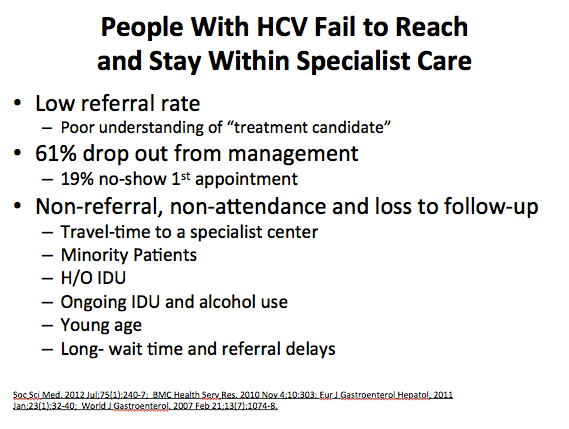
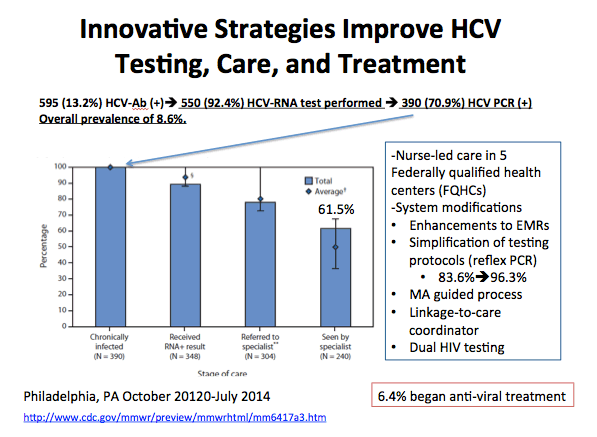
National Nursing Centers Consortium (NNCC) carried out a project to integrate routine HCV testing and linkage-to-care in five federally qualified health centers in Philadelphia, PA, that primarily serve homeless persons and public housing residents. During the project period, 4,514 patients across the five centers were tested for HCV. Of these, 595 (13.2%) were HCV-antibody positive and 550 (92.4%) had a confirmatory HCV-RNA test performed. Of those who had a confirmatory HCV-RNA test performed, 390 (70.9%) were identified as having current (i.e., chronic) HCV infection (overall prevalence = 8.6%). Of those currently infected with HCV, 90% were informed of their status, 78% were referred to an HCV care specialist, and 62% went to the referred specialist for care. Replicable system modifications that improved HCV testing and care included enhancements to electronic medical records (EMRs), simplification of HCV testing protocols, and addition of a linkage-to-care coordinator. Findings from this project highlight the need for innovative strategies for HCV testing, care, and treatment, as well as the important role of community health centers in expanding access for patient populations disproportionately affected by HCV infection (1).
CDC Report: Routine HCV Screening Project in Philadelphia finds High HCV-Infection Rate, 8.6% infected with HCV: CDC Report - "Identification and Linkage to Care of HCV-Infected Persons in Five Health Centers - Philadelphia, Pennsylvania, 2012-2014" - (05/20/15)
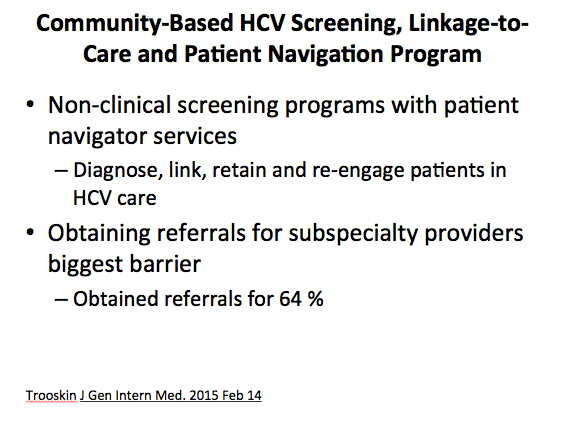
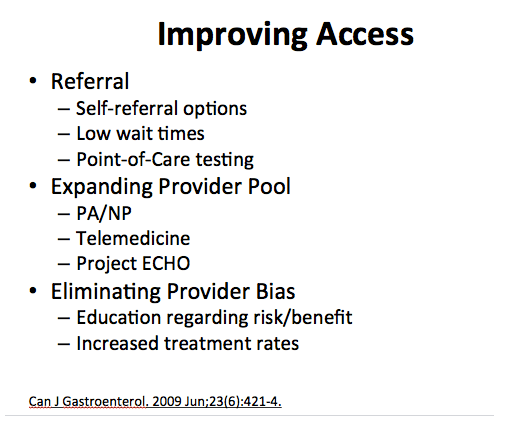
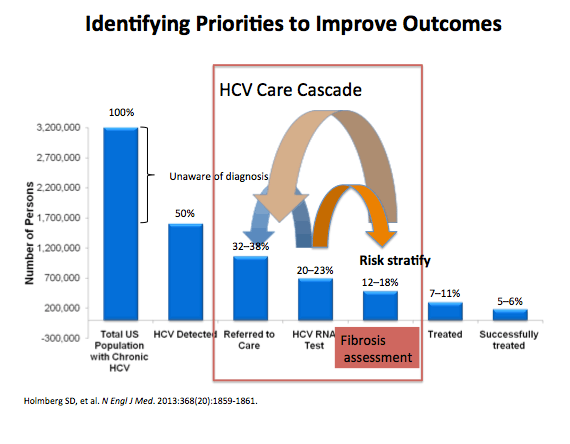
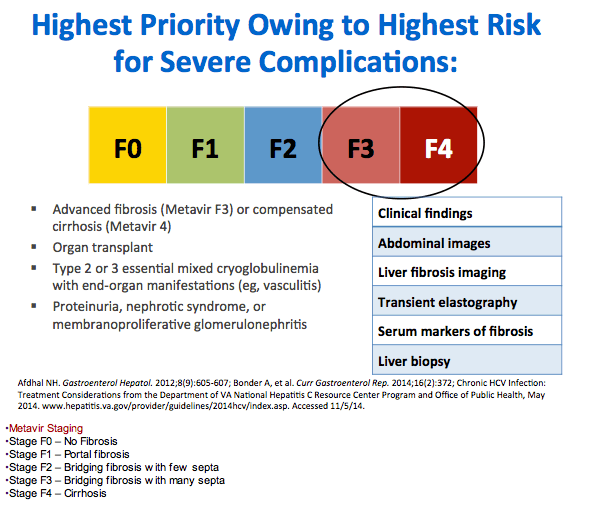
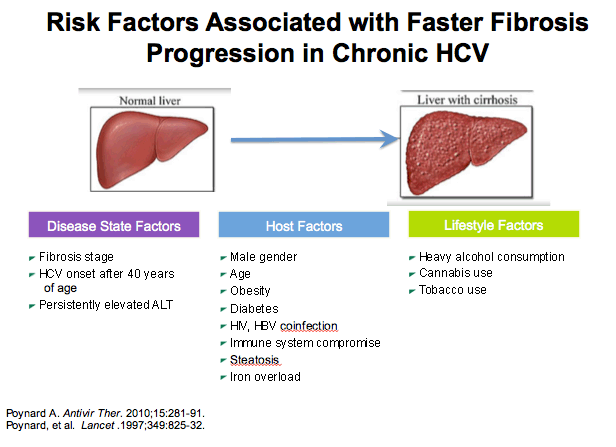
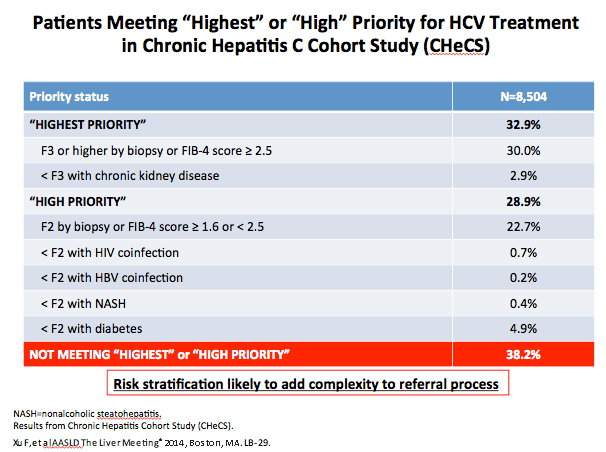
LB-29: Patients Meeting 'Highest' or 'High' Priority for HCV Treatment in the Chronic Hepatitis Cohort Study (CHeCS)
Objective: The new AASLD/IDSA treatment guidelines (August 2014) formalized criteria for prioritizing care among
patients seeking treatments for hepatitis C virus (HCV) infection. We sought to quantify the number and percentage of
patients meeting the criteria of 'highest' or 'high' priority for HCV treatment, using data from an ongoing cohort study.
Methods: Data were drawn from the Chronic Hepatitis Cohort Study (CHeCS), an ongoing observational cohort study
of patients receiving care for chronic HBV or HCV infections at 4 integrated US healthcare systems: Geisinger Health
System, Danville, PA; Henry Ford Health System, Detroit, MI; Kaiser Permanente-Northwest, Portland, OR; and
Kaiser Permanente-Honolulu, HI. We analyzed clinical data for HCV-infected patients still living as of December 2011,
excluding those who had died, had achieved sustained virologic response, or had received a liver transplant. Patient's
fibrosis stage was based on FIB-4 scores derived from serum tests or biopsy results, if available. The FIB-4 scores
cutoff values of 2.5 and 1.6 were the upper limits of mean FIB-4 scores in CHeCS patients who had biopsy-confirmed
Metavir F3 or F2 stage of fibrosis, respectively. Laboratory tests and ICD-9 codes were used to identify patients with
extrahepatic manifestations and qualifying comorbidities. Some conditions, like severe cryoglobulinemia and
debilitating fatigue, were not assessed due to lack of a reliable laboratory test or ICD-9 code.
Results: Of 10,786 patients with HCV infection, 2,339 (21.7%) had a biopsy in 2004 or later, and 7,777 (72.1%) had
no biopsy but had laboratory results available to a calculate FIB-4 score; only 6.2% had neither. Of the 10,116
patients that could be staged by biopsy or FIB-4 score (Table), 3,364 (33.3%) were staged at F3 or higher based on
the latest biopsy or FIB-4 score (Table), using a cutoff of FIB4 ≥2.5. Only 3271 (32.3%) had less than F2 fibrosis and
did not have comorbid conditions we could assess, thus these patient did not qualify for 'highest' or 'high' priority for
treatment.
Conclusions: In a large U.S. cohort of patients with HCV infection at least two-thirds of patients would meet the
'highest' or 'high' criteria for treatment according to the new treatment guidelines. However, these patients' immediate
access to new therapies is challenged by treatment costs and other barriers.
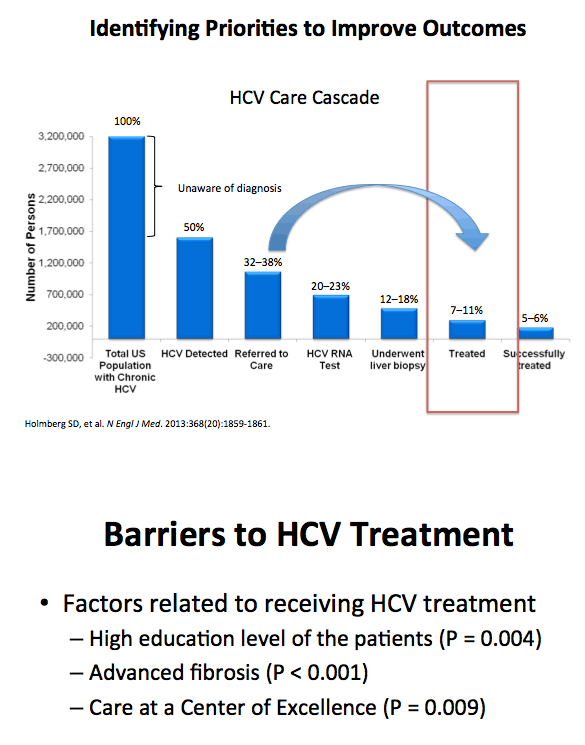
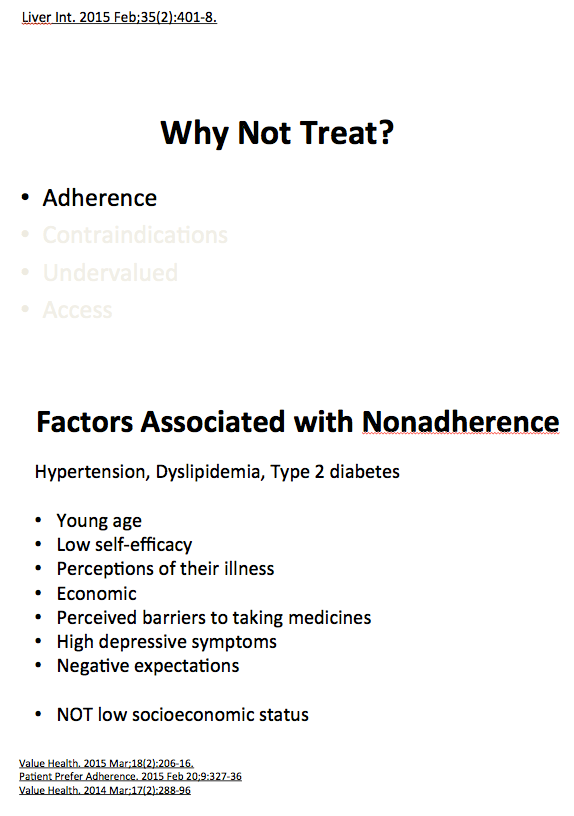
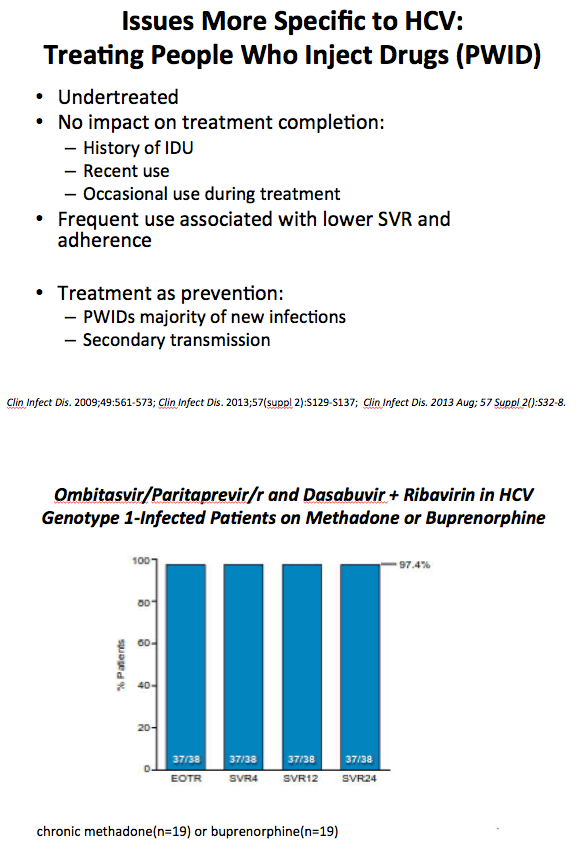
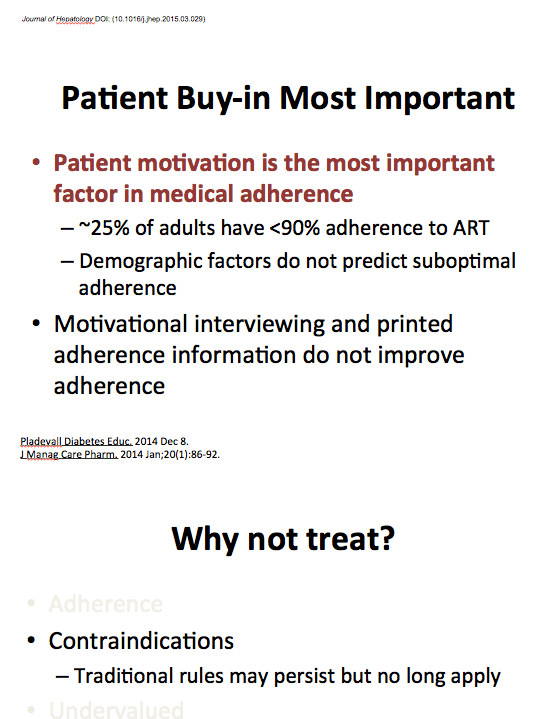

Transition
·On this slide, the factors associated with receiving NOT treatment are summarized
Main Messages
·In this large database representing a real world population, 15-17% of those identified with HCV were treated with interferon-based regimens
·Factors associated with receiving treatment with interferon included: age 45-65, male gender, cirrhosis, HIV, NAFLD, depression, prior liver transplant
·Those with conditions that predispose to more aggressive disease are more likely to receive treatment
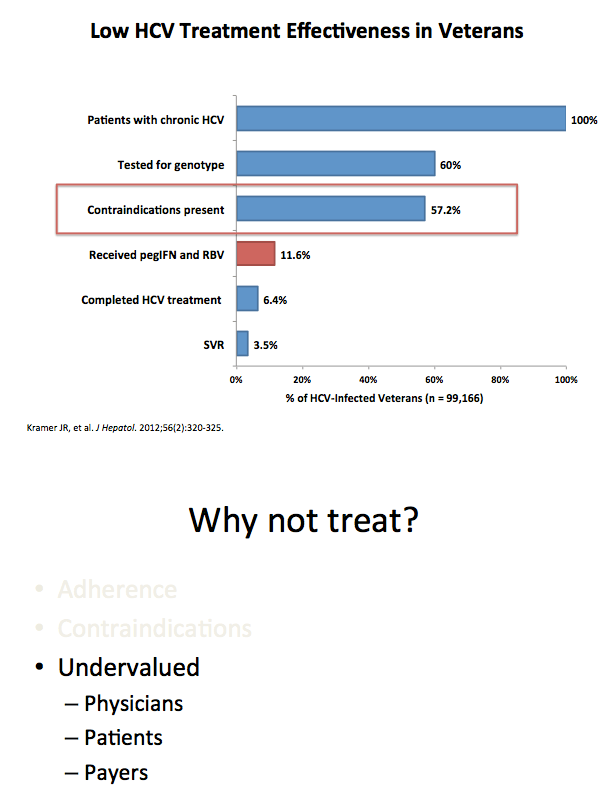
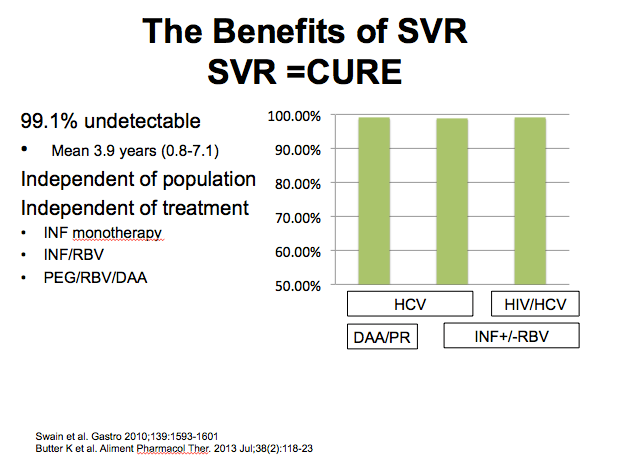
Mean 3.9 years (0.8-7.1)
Abstract
BACKGROUND:
The introduction of direct-acting anti-virals has increased sustained virological response (SVR) rates in chronic hepatitis C genotype 1 infection. At present, data on long-term durability of viral eradication after successful triple therapy are lacking.
AIM:
To evaluate the long-term durability of viral eradication in patients treated with triple therapy, including direct-acting anti-virals.
METHODS:
Patients who participated in randomised, controlled trials or an extended access programme of treatment with peginterferon-α2a/ribavirin in combination with a direct-acting anti-viral (telaprevir, danoprevir, faldaprevir, simeprevir, mericitabine, balapiravir) were followed after achieving SVR. The median follow-up after the patients was 21 (range: 7-64) months.
RESULTS:
One hundred and three patients with chronic hepatitis C genotype 1 infection [f/m: 34/69; GT-1b: 67 GT-1a: 34, GT-4: 2; mean age: 47.6 years (45.5-49.7; 95% CI)] achieving a SVR triple therapy were followed. Two cases of late relapses (2/103, 1.9%; 95% CI: 0.24-6.8) were observed. One patient was cirrhotic, both carried the genotype 1b and completed the prescribed treatment. The relapses occurred 8 and 12 months after cessation of anti-viral treatment. Cloning sequencing revealed identical sequence in both patients. Resistance analysis revealed no presence of viral resistance.
CONCLUSION:
Like the SVR after peginterferon-α2/ribavirin combination treatment, HCV eradication after triple therapy remains durable after long-term follow-up.
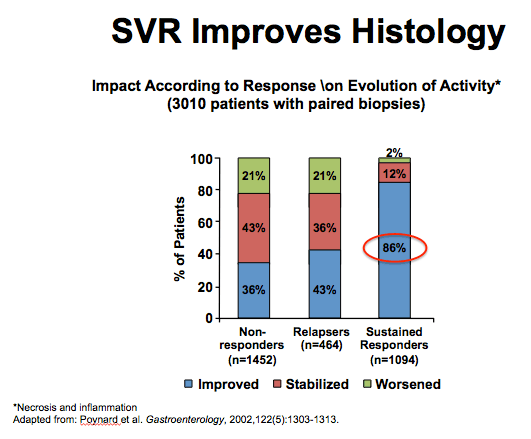

Post-SVR12 improvements in PRO scores. All P < 0.0001, except for WPAI: absenteeism (P > 0.05). Abbreviations: BP, bodily pain; GH, general health; MCS, mental component summary; MH, mental health; PCS, physical component summary; PF, physical functioning; RE, role emotional; RP, role physical; SF, social functioning; VT, vitality.
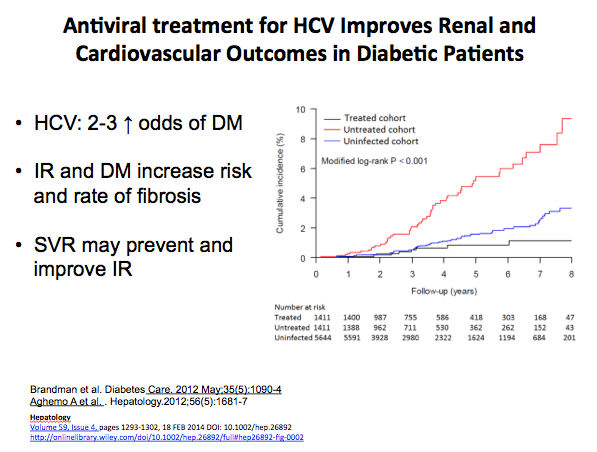
Cumulative incidence of ESRD in three study cohorts, analyzed by the modified log rank test with death adjusted as a competing risk event.
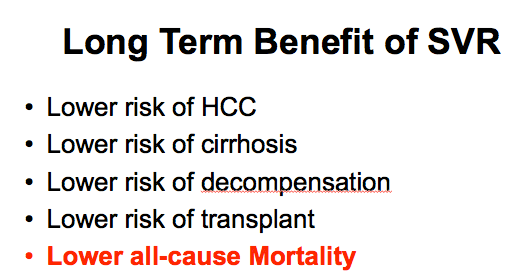
Post-hoc analysis after prolonging the follow-up in this cohort indicated a poorer survival among
patients in the interferon maintenance arm, as the cumulative 7-year mortality rate was 20%
in treated and 15% in control patients (p=0.049)
Improved histology could explain the reduction in portal pressure among patients with
SVR, as measured by the hepatic venous pressure gradient (HVPG) [50-52].
histology could explain the reduction in portal pressure among patients with
SVR, as measured by the hepatic venous pressure gradient (HVPG) [50-52]. Importantly, the
HVPG is one of the best validated surrogate markers within the field of hepatology, as higher
HVPG levels are associated with worse clinical outcome and RCTs have indicated that
interventions to reduce the portal pressure resulted in both decreased HVPG levels as well
as improved clinical outcome [12, 53-55]. Indeed, cirrhotic patients with chronic HCV
infection who attained SVR did not develop esophageal varices or variceal bleeding
EASL: Improvement in Liver Function and Non-Invasive Estimates of Liver Fibrosis 48 Weeks after Treatment With Ombitasvir/Paritaprevir/r, Dasabuvir, and Ribavirin in HCV Genotype 1 Patients With Cirrhosis - (04/24/15) post-SVR markers of HCV disease improved including all- non-ivasive estimates of liver fibrosis - FibroTest, APRI, FIB-4, FORNS Index
EASL: HEALTHCARE ECONOMICS / SVR Improves Health, Mortality / Early HCV Therapy Prefer - (05/14/15)
EASL: Effect of Long-Term Viral Suppression With Sofosbuvir + Ribavirin on Hepatic Venous Pressure Gradient in HCV-Infected Patients With Cirrhosis and Portal Hypertension - (04/29/15)
EASL: Time Course of Hepatic Improvement using the HepQuant® (HQ)-SHUNT Function Test during and after Treatment with Ledipasvir/Sofosbuvir in Liver Transplant Recipients with Allograft Fibrosis or Cirrhosis and Patients with Decompensated Cirrhosis who have not undergone Transplantation - (04/29/15)

CLINICAL EFFICACY OF HIGHLY EFFECTIVE INTERFERON-FREE THERAPY IN PATIENTS WITH CHRONIC HCV INFECTION AND COMPENSATED ADVANCED HEPATIC FIBROSIS - Life Expectancy in Patients With Chronic HCV Infection and Cirrhosis Compared With a General Population (Van de Meer et al AASLD 2014)........http://www.natap.org/2014/AASLD/AASLD_89.htm
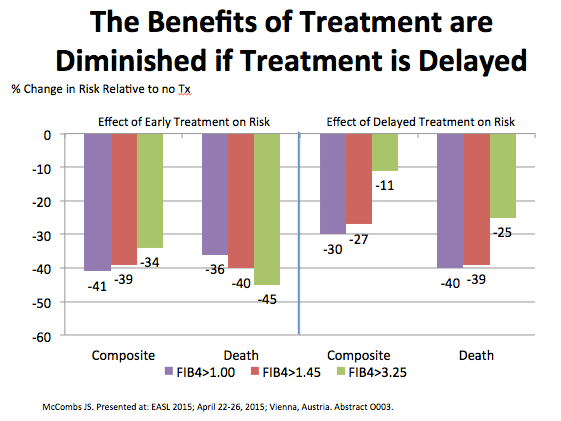
Using a lower cutoff value of 1.45, a FIB-4 score <1.45 had a negative predictive value of 90% for advanced fibrosis (Ishak fibrosis score 4-6 which includes early bridging fibrosis to cirrhosis). In contrast, a FIB-4 >3.25 would have a 97% specificity and a positive predictive value of 65% for advanced fibrosis. In the patient cohort in which this formula was first validated, at least 70% patients had values <1.45 or >3.25. Authors argued that these individuals could potentially have avoided liver biopsy with an overall accuracy of 86%.
EASL: CAN HEPATITIS C TREATMENT BE SAFELY DELAYED?: EVIDENCE FROM THE VETERANS ADMINISTRATION HEALTHCARE SYSTEM - (04/28/15) McCombs et al EASL 2015
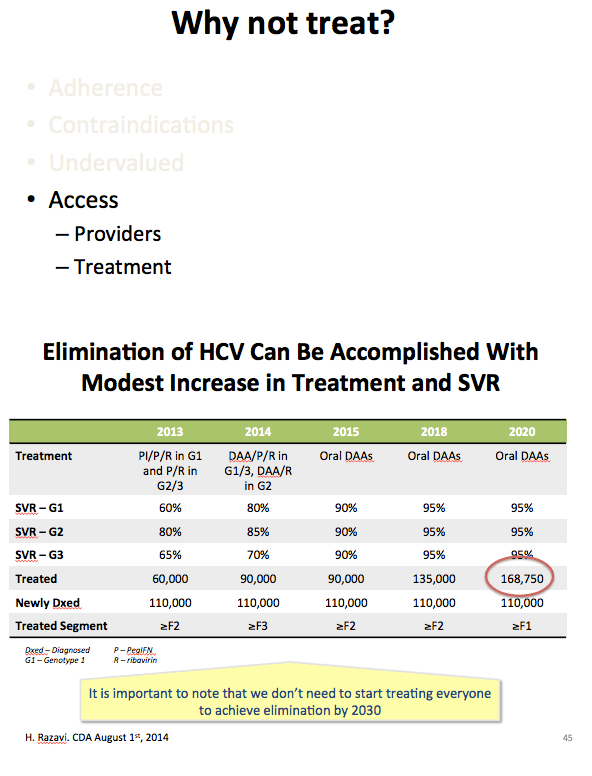
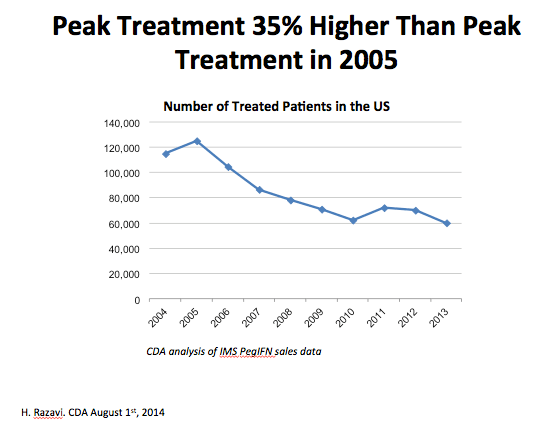
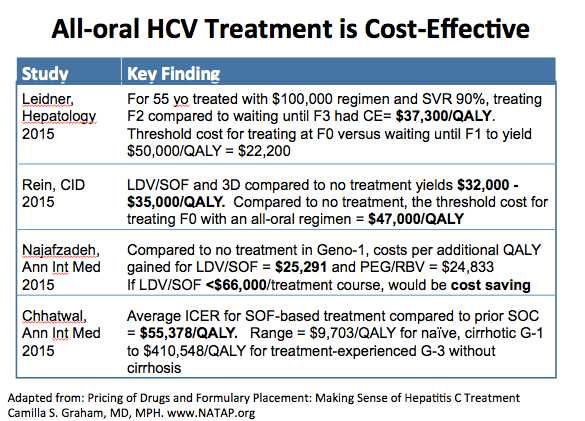
Cost-effectiveness of hepatitis C treatment for patients in early stages of liver disease - (03/16/15) Leidner Hepatology 2025
The Cost-effectiveness, Health Benefits, and Financial Costs of New Antiviral Treatments for Hepatitis C Virus and Editorial - (03/16/15) Rein CID 2025
Cost-Effectiveness of Novel Regimens for the Treatment of Hepatitis C Virus - (03/18/15) .....17 March 2015 Ann Intern Med....Mehdi Najafzadeh, PhD
Cost-Effectiveness and Budget Impact of Hepatitis C Virus Treatment With Sofosbuvir and Ledipasvir in the United States - (03/18/15).....17 March 2015 Ann Intern Med......Jagpreet Chhatwal, PhD

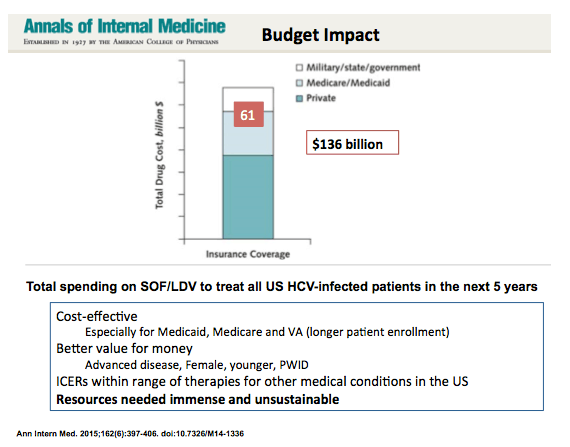

Payers would need $136 billion to cover drug costs for all treatment-eligible patients with HCV during the next 5 years, $61 billion of which would need to be paid by the government (additional $65 billion over oSOC). Cost offsets would only be $16 billion (24%)
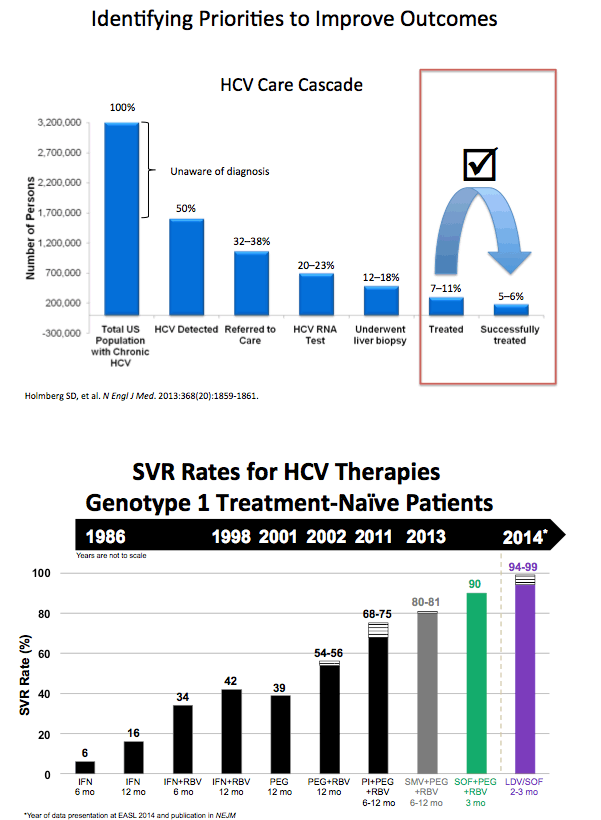
Adapted from Strader DB, et al. Hepatology 2004;39:1147-71. INCIVEK [PI]. Cambridge, MA: Vertex Pharmaceuticals; 2013. VICTRELIS [PI]. Whitehouse Station, NJ: Merck & Co; 2014. Jacobson I, et al. EASL 2013. Amsterdam. The Netherlands. Poster #1425. Manns M, et al. EASL 2013. Amsterdam.
The Netherlands. Oral #1413. Lawitz E, et al. APASL 2013. Singapore. Oral #LB-02; Afdhal N, et al.
N Engl J Med 2014; 370: 1889-98; Kowdley K, et al. N Engl J Med 2014; 370: 1879-88.
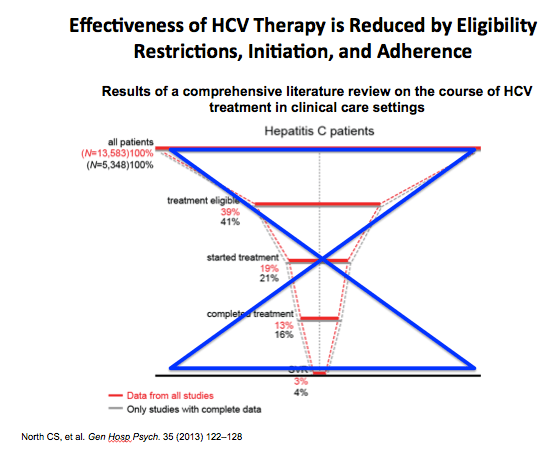
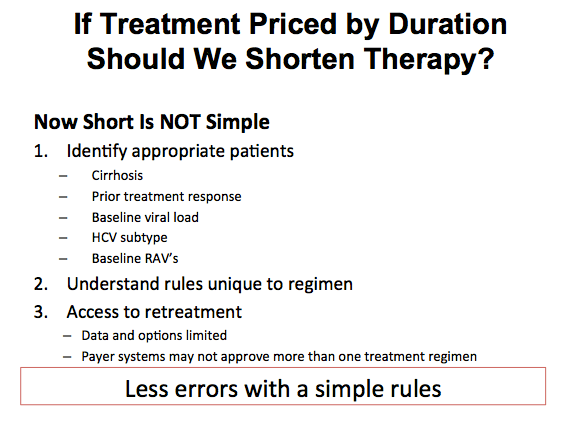
Cumulative incidence of hepatocellular carcinoma stratified according to response to treatment (p<0.001, by log-rank test). SVR, sustained virological response.
Background & Aims
Hepatocellular carcinoma (HCC) currently represents the major cause of liver-related death in patients with hepatitis C virus (HCV)-related cirrhosis. We assessed the influence of combination therapy on the risk of HCC, liver-related complications (ascites, variceal bleeding), and liver-related death (or liver transplantation).
Methods
Three hundred seven chronic hepatitis C patients with bridging fibrosis (n=127) or cirrhosis (n=180) were evaluated by Cox regression analysis. Sustained virological response (SVR) was defined as undetectable serum HCV RNA at 24weeks after treatment.
Results
SVR developed in 33% of patients. The SVR rates were not different between patients with bridging fibrosis (37%) and those with cirrhosis (30%), p=0.186. During a median follow-up of 3.5years (range 1-18years) after the last treatment, the incidence rates per 100 person-years of HCC, liver-related complications, and liver-related death, were 1.24, 0.62, and 0.61 among SVR patients, respectively, and 5.85, 4.16, and 3.76 among non-SVR patients, respectively (log-rank test, p<0.001). According to multivariate analysis, non-SVR was an independent predictor of HCC (HR 3.06; 95% CI=1.12-8.39), liver-related complications (HR 4.73; 95% CI: 1.09-20.57), and liver-related death (HR 3.71; 95% CI=1.05-13.05).
Conclusions
SVR is achieved in one-third of patients with HCV-related cirrhosis treated with peginterferon and ribavirin. SVR has a strong independent positive influence on the incidence of HCC and on the prognosis of these patients.
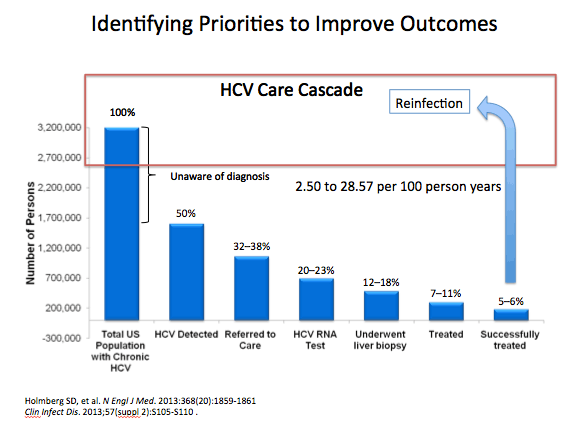
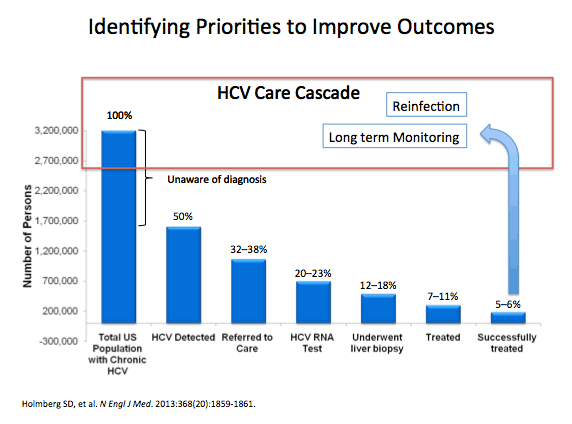
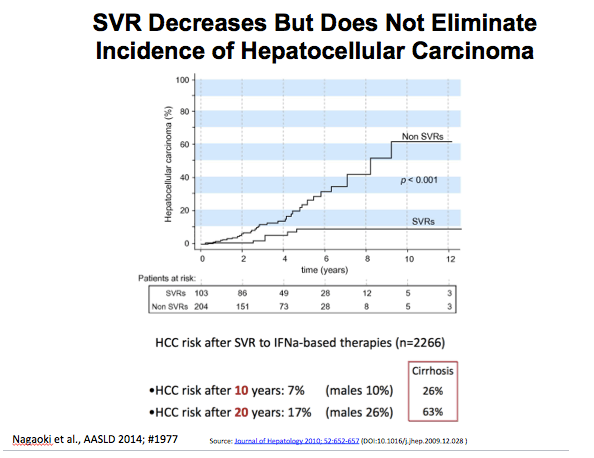
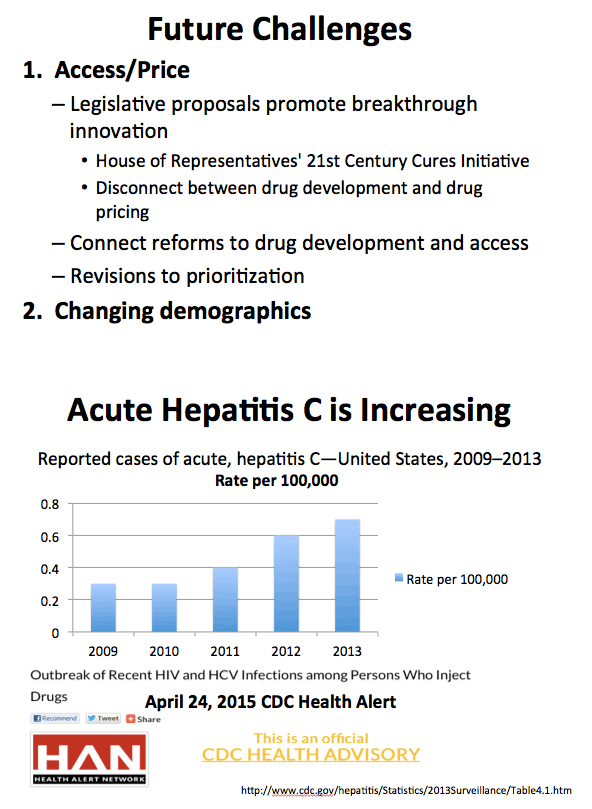
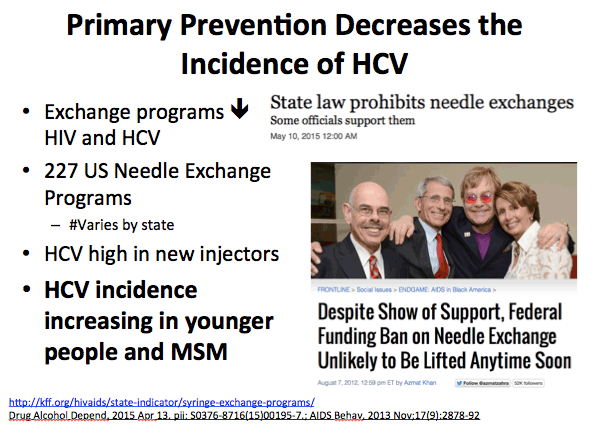
The highest reported age-specific incidence of acute hepatitis C in the United States is now among persons aged 20-29 years. Prior to 2001, most U.S. reports of acute hepatitis C occurred among persons aged 30-49 years.
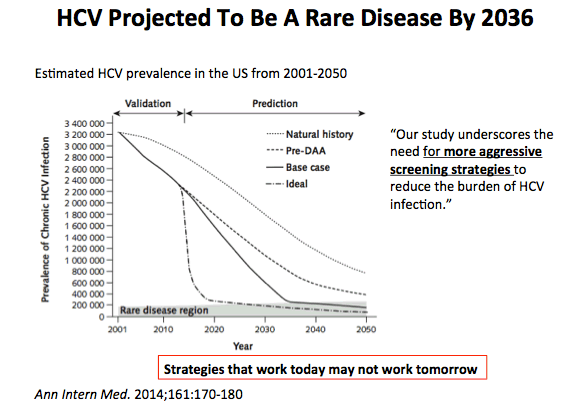
Our model projected that the cases of chronic HCV infection in the United States decreased from 3.2 million in 2001 to 2.3 million in 2013 (Figure 2). From 2001 to 2013, a total of 157 300 HCV-infected persons died of liver-related complications, 415 000 died of other causes, and 589 100 achieved SVR. During the same period, 251 000 new persons became chronically infected with HCV. Considering the population growth in the United States (50), we projected that HCV infection would be- come a rare disease by 2036 (that is, it would affect approximately 1 in 1500 persons, or less.) (51).
|
| |
|
 |
 |
|
|